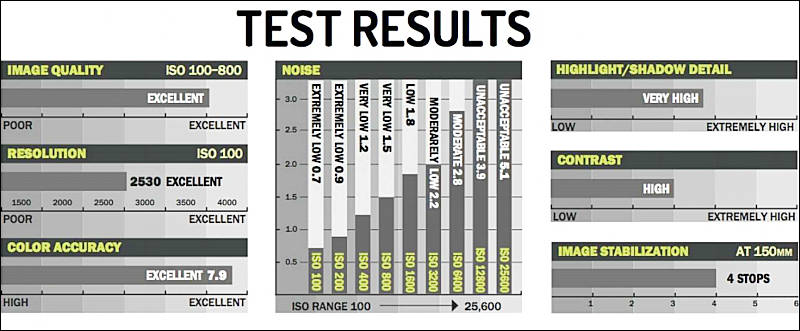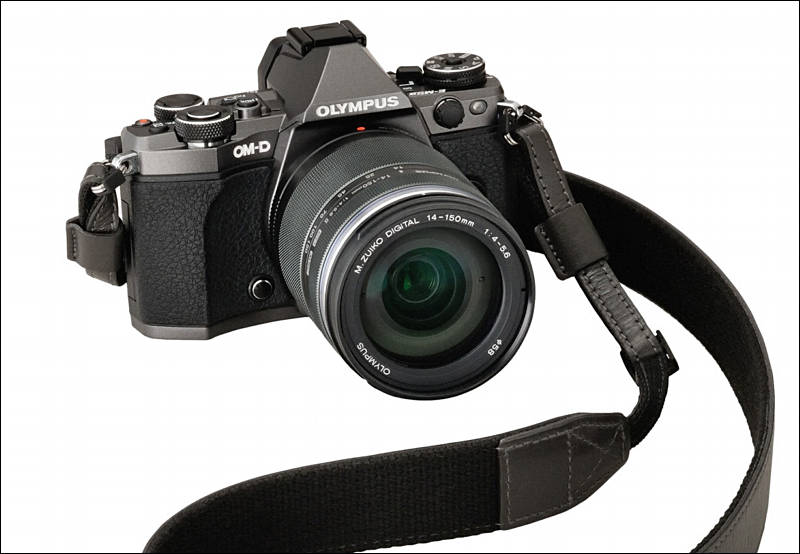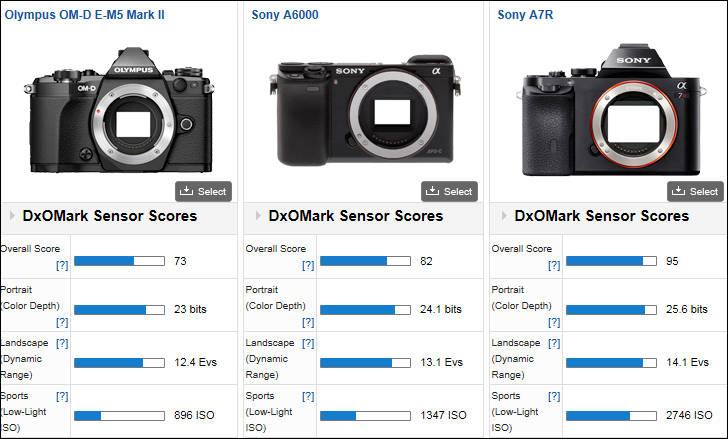
It allows to keep PV going, with more focus towards AI, but keeping be one of the few truly independent places.
-
Thanks for your effort! :-)
-
Thank you.
-

 sales7.jpg800 x 598 - 67K
sales7.jpg800 x 598 - 67K -
Firmware version 1.1 fixes the following issues:
- Function has been modified so that audio can be faded out of movie files created with My Clips editing.
- Speed at which information is displayed when the camera is turned on has been improved.
- The issue of noise appearing in images captured while shooting with High Res Shot has been corrected.
-
For stabilizing the footage, do EM-5 purely done it only using IBIS or they also add some extra crop to allow digital stabilization as well? I am curious about their technology. If it does need extra crop to have that gorgeous stabilized footage, then what is the actual crop factor in video mode?
-
@yskunto I calculated it to be be about 2.5 X and it is cropped IBIS on or off which was one of the reasons I returned mine.
-
Well, then IBIS plus the extra crop is not an "interstellar" technology. I believe if the other m43 manufacturer want to do a similar stabilized technology, then they can also implement it using Optical Image Stabilizer system plus the extra crop.
-
@yskunto I actually disagree one of the first things I learned to do was to only use the hardware stabilization. The combo with software stabilization would do some crazy things sometimes. You can always add software stabilization in post. That being said the hardware only IBIS totally blows away optical stabilization IMO. They just need to learn to do it with out the huge crop factor. I also think it is the future. Maybe Olympus should strike a deal with Black Magic IBIS for BM and video processing tech for Olympus.
-
GH4 is 2.3x. They wont ever get 2x with 'effective' stabilisation, which is preferred because software methods make things soft
-
@Scot I agree with you. Olympus is really close to becoming a perfect video system with their stabilized system. Once they able to master the video codec, then they good to go. About the crop factor, I think if they able put a slightly bigger sensor, then the need for extra crop will be less.
-
yes a larger sensor for some overlap would be a benefit, but it would get optically less perfect at the edges if taken to extremes. Perhaps in the interim they need that ultra wide online asap.
-
The problem with the Olympus crop is it is cropped all the time IBIS on or off any mode. When I've locked my camera down on a tripod and no longer need stabilization I don't want to continue being penalized for a feature I am not even using. I also think that the additional software stabilization mode is responsible for much of that crop and that they made a bad decision to go with it when it is readily available in post. Of course it was not the only reason I returned mine though it was a significant factor.
-

If you’re a veteran of the Micro Four Thirds world and looking for a small DSLR-style camera body, the Olympus E-M5 Mark II is a wonderful option. It serves up excellent quality images—some of the best that you’ll find from this format of sensor.

 compare17.jpg800 x 331 - 56K
compare17.jpg800 x 331 - 56K -
OM-D E-M5 Mark II Limited Edition evokes titanium-plated OM icon

Award-winning OM-D pays homage to 90s titanium classic
For fans of landmark high-end cameras, the 1994 OM-3Ti is an all-time classic, and now collectors can acquire a contemporary homage to this titanium-clad SLR icon: a limited-edition version of its most recent OM-D descendant, the TIPA award-winning OM-D E-M5 Mark II*. The beautifully redesigned E-M5 Mark II will be available in a distinctively retro, titanium-tinted body that evokes the golden age of the original Olympus OM series, a period that laid the foundations for the flagship Olympus Micro Four Thirds cameras of today. In addition to the titanium colour, the Limited Edition differs from the regular model with a special OM-D-branded leather strap, an owner’s card bearing a quote from the legendary OM designer, Yoshihisa Maitani, and a premium-stitched leather case for the card. A number between one and 7,000 will appear on the other side of the card, as only 7,000 of these cameras are due to be made. The OM-D E-M5 Mark II Limited Edition will be available from June 2015 as the body only, or in a kit with the all-round zoom M.ZUIKO DIGITAL ED 14-150mm 1:4.0-5.6 II lens. The body will retail for £999.99. The lens kit will cost £1349.99.
One portable icon deserves another
Although some 20 years have passed since the launch of the OM-3Ti, the OM-D E-M5 Mark II Limited Edition has much in common with its illustrious forebear, and not just visually. Both offer serious photographers a more portable, high-grade alternative to bulkier SLRs. The 1980s and 90s cemented the OM series’ reputation for compact, lightweight, go-anywhere system cameras as well as innovations such as the air damper that muffled the shock of mirror movement or the multi-spot metering mechanism beloved of professional owners of the OM-4. The E-M5 Mark II continues that tradition with its minimal dimensions, rugged build, and the world’s most powerful** 5-axis Image Stabilization system. This – as the TIPA award jury pointed out – makes it ideal for high-speed, spontaneous photography on the move (“a breakthrough technology that handles virtually every shooting situation.”).
OM-D E-M5 Mark II Limited Edition AT A GLANCE:
- Exclusive collector’s item with just 7,000 due to be built
- Distinctive titanium-style finish pays evokes the iconic OM-3Ti
- Supplied with luxurious OM-Dbranded leather strap, exclusive owner’s card and premium leather card case
A titan in titanium
Beginning with the launch of the OM-1 in 1973, Yoshihisa Maitani’s breakthrough series married form with professional-grade function, and the OM-3Ti was the beautiful – and practical – culmination of this design philosophy. Its titanium plates were not just lighter than aluminium, they were also more resistant to corrosion and heat, and fully six times more robust. Visually, they ensured the OM-3Ti stood out from every other camera available at that time.
The OM-D E-M5 Mark II Limited Edition pays homage to this heritage with a striking new colour and a number of unmistakable OM design cues. In addition to the familiar, angular OM contours, prism mount and low centre of gravity, the new camera woos collectors with its distinctive titanium-style finish as well as the exquisitely knurled dials and shutter release. From the perspective of its owner, the controls ooze state-of-the-art optical precision.
20th-century history, 21st-century quality
The design of the OM-D E-M 5 Mark II Limited Edition may hark back to the 80s and 90s, but in every other respect it is very much a cutting-edge example of the best optical engineering on offer today, as acknowledged by TIPA when they singled out a number of features (other than the 5-axis IS) for praise: “Housed in a dustproof, splashproof and freeze-proof magnesium alloy body, the 16.1 Megapixel 4/3 Live MOS sensor and TruePic VII processor of the Olympus OM-D E-M5 Mark II deliver a wide array of creative imaging options and an ISO up to 25,600. The camera sports a 2.36 million-dot Electronic Viewfinder and a 3-inch 1,037K-dot swivel touchscreen LCD monitor. Its extremely quick Fast AF boasts an 81-point area, excellent low-light performance and tracking AF, delivering fast AF for the camera’s 10 frames-per-second rate at full resolution. The camera also has a special ‘High-Res Shot’ option that is said to deliver resolution equivalent to a 40 Megapixel sensor by combining 8 shots into a single JPEG using sensor shift.”
Of course, the most recent addition to Olympus’ OM-D family will be celebrated primarily for its remarkable titanium looks, luxurious leather accessories and the powerful sense of heritage it conveys to anyone who holds it. But in essence it remains a sophisticated tool for the spontaneous creative photographer and videographer. It is smaller and much lighter than comparable SLRs and, as such, it enables filmmakers to capture handheld movies outdoors without carrying additional, bulky equipment – blur- and noise-free – irrespective of poor light. As a tribute to his benchmark OM cameras of yesteryear, Yoshihisa Maitani would surely approve

 dog_23.jpg800 x 554 - 54K
dog_23.jpg800 x 554 - 54K -
As an owner of an OM-4t, titanium body that color is too dark. The OM-3t was same color. I would say the original color is more of a champagne. Still nice looking color....
-
Preorder of limited edition - http://www.adorama.com/IOMEM5M2SE.html
-
Ming Thein's review of the E-M5 II: http://blog.mingthein.com/2015/05/21/review-olympus-e-m5-mark-ii/
Kind of critical, but I agree with a lot of the critics. And put in context (comparing it for work, where he uses the D810).
He mentions the HDMI out for video, and I've remembered: anyone here used the E-M5 II with a Ninja Star?
Howdy, Stranger!
It looks like you're new here. If you want to get involved, click one of these buttons!
Categories
- Topics List23,991
- Blog5,725
- General and News1,353
- Hacks and Patches1,153
- ↳ Top Settings33
- ↳ Beginners256
- ↳ Archives402
- ↳ Hacks News and Development56
- Cameras2,367
- ↳ Panasonic995
- ↳ Canon118
- ↳ Sony156
- ↳ Nikon96
- ↳ Pentax and Samsung70
- ↳ Olympus and Fujifilm101
- ↳ Compacts and Camcorders300
- ↳ Smartphones for video97
- ↳ Pro Video Cameras191
- ↳ BlackMagic and other raw cameras116
- Skill1,960
- ↳ Business and distribution66
- ↳ Preparation, scripts and legal38
- ↳ Art149
- ↳ Import, Convert, Exporting291
- ↳ Editors191
- ↳ Effects and stunts115
- ↳ Color grading197
- ↳ Sound and Music280
- ↳ Lighting96
- ↳ Software and storage tips266
- Gear5,420
- ↳ Filters, Adapters, Matte boxes344
- ↳ Lenses1,582
- ↳ Follow focus and gears93
- ↳ Sound499
- ↳ Lighting gear314
- ↳ Camera movement230
- ↳ Gimbals and copters302
- ↳ Rigs and related stuff273
- ↳ Power solutions83
- ↳ Monitors and viewfinders340
- ↳ Tripods and fluid heads139
- ↳ Storage286
- ↳ Computers and studio gear560
- ↳ VR and 3D248
- Showcase1,859
- Marketplace2,834
- Offtopic1,320













